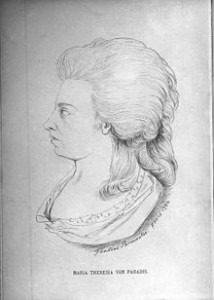
Maria Theresia Paradis
Maria Theresia Paradis was an accomplished singer, talented composer and virtuoso pianist who performed in various Viennese and European salons and concerts. Although she lost her eyesight early on, her musical talents were quickly recognized. Educated by Antonio Salieri (singing and composition) and Abbé Vogler (music theory and composition), Paradis gave her first public performances at age 12. She also actively commissioned an organ concerto from Salieri, and a piano concerto from Haydn and Mozart, respectively. At the height of her career, she had more than 60 piano concertos in her memorized repertory. Extended tours of Germany, Switzerland and England led to her first appearance in Paris in March 1784. A reviewer wrote, “one must have heard her to form an idea of the touch, the precision, the fluency and vividness of her playing.” In all, Paradis made 14 concert appearances in Paris, and she also assisted Valentin Haüy in the establishment of the first school for the blind, which opened in 1785.
The series of piano concertos Wolfgang Amadeus Mozart composed during his initial years in Vienna are undoubtedly his greatest achievement in instrumental music. They represent compositions of the highest quality and originality. According to Maynard Solomon, “their artistry goes far beyond the concertos of his predecessors or his contemporaries in their scale, their thematic richness and their highly developed relationship between soloist and orchestra.” During1784, Mozart composed a total of six piano concertos. Although mainly written for his personal use, it has been suggested that the concerto K. 456 was composed on commission from Maria Theresia Paradis. Evidence of the commission comes from a letter from Leopold Mozart to Nannerl, describing “a glorious concerto written for Paradis for Paris.” Although the letter is inconclusive, there is no doubt that Mozart crafted an assured and confident work with a supremely entertaining piano part. The string section in the opening “Allegro” sounds a delightful little march, which is immediately taken up by the woodwinds. Subsequently, the whole orchestra plays a forceful transition that harmonically drifts towards the lyrical contrast. In a touch of genius, Mozart infuses this theme with various minor inflections, before stylized hunting calls conclude the orchestral exposition. The pianist restates the opening theme and is eventually joined by the orchestra. Both performing forces artfully embellish the musical material, and an extended transition prepares for the entrance of the lyrical theme. A light-hearted musical dialogue between the solo piano and the woodwinds characterizes the development, before the themes stated at the beginning of the movement are repeated. Mozart wrote two different cadenzas for this movement, possibly providing Paradis with a pianistic choice. The slow movement unfolds as a series of variations on a bittersweet theme, while the concluding rondo artfully contrasts an innocent music-box theme with flashes of virtuoso brilliance.
Wolfgang Amadeus Mozart: Piano Concerto No. 18 in B-flat Major, K. 456


How did she learn the score? Did Mozart teach it to her and she memorised it?